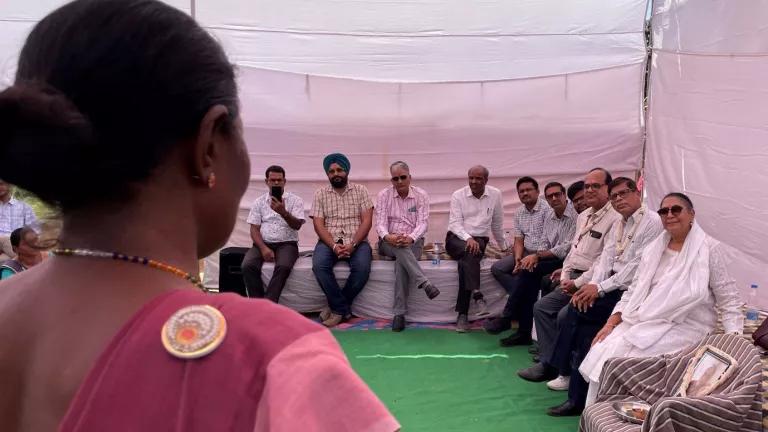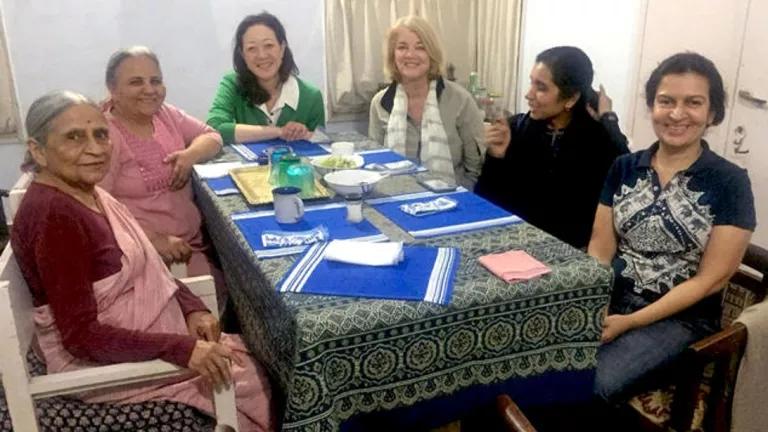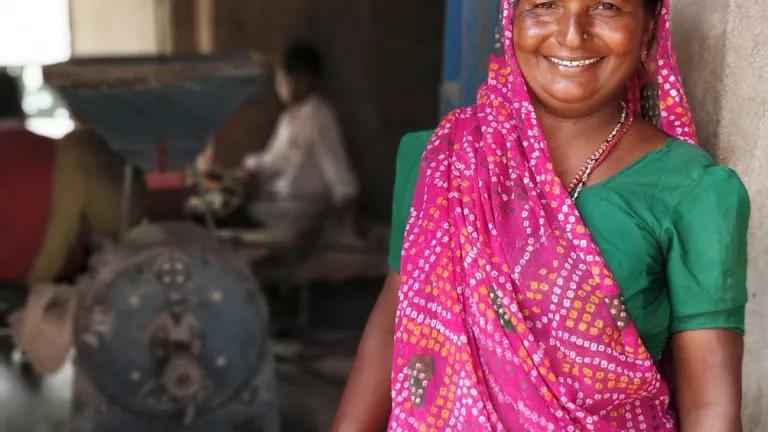People-Centric Approaches to Climate Solutions
Local climate action and people-centric approaches are critical to building on the ground capacities of communities vulnerable to the impacts of climate change.

SEWA sister sharing her experiences with the state officials on adoption of climate friendly technologies.
NRDC India
Guest blog by Akanksha Golchha of NRDC India
Local climate action and people-centric approaches are critical to building on the ground capacities of communities vulnerable to the impacts of climate change: this was a key takeaway of the national workshop on Building Climate Resilience of Communities through State Action, organized by Ministry of New And Renewable Energy (MNRE), Association of Renewable Energy Agencies of States (AREAS), NRDC India, and Self Employed Women’s Association (SEWA), in partnership with the Rajasthan Renewable Energy Corporation Limited (RREC). The workshop focused on identification of pathways to fast-track the uptake of various clean energy and climate resilient interventions that are based on local environments and experiences. Developing policies and plans that are local and community-centric is crucial given India’s diverse topography with six climatic zones that are vulnerable to different climate events. A people-centric clean energy transition allows communities and governments to center key aspects of just transition including equity, inclusion, and livelihoods while focusing on economic development.
The workshop, which revolved around multi-dimensional topics of climate change and building community resilience, comes on the heels of Indian states making significant strides in renewable energy deployment and building climate resilience through local action. Rajasthan’s Jodhpur Heat Action Plan, launched earlier this year, for example, addressed the risks caused by extreme heat and the changing climate.
The workshop covered topics such as capacity building for technology adoption to preparing local strategies to build community-centric climate reliance such as heat action plans and cooling solutions. The officials from the State Nodal Agencies (SNAs) also shared the best practices adopted by their states, effectively ensuring that the workshop also enable cross-learning and experience sharing. Participants from the SNAs also traveled to Berania village, a Hariyali Gram where a suite of climate friendly solutions have been adopted by various households. This was the second such workshop that brought together central and state government officials, industry, researchers, and civil society – the first workshop was organized in Gujarat in June 2022.
Based on the discussions, the key people-centric approaches that can enhance climate resilience and support a clean energy transition at the community level are summarized below:
- Formalize distributed renewable energy implementation: Formalizing a distributed renewable energy (DRE) programme at the sub-national level through a government scheme will contribute in improving the quality of the electricity supplied in the rural areas. This can also include a list of commercially viable off-grid solutions in tandem with the local climate needs. This list could also support the generation of livelihoods which could have both a positive impact on both local economy and the climate. The cumulative impact of DRE implementation would have the added benefit of contributing immensely to meeting India’s renewable energy target.
- Innovate financial mechanisms: Rural households, especially women, often have limited access to formal financial mechanisms due to multiple socio-economic dynamics including minimal asset ownership. Innovative finance mechanisms, such as partial risk guarantee, facilities and incentives, and interest subvention schemes, are required to make finance more accessible to rural households. Innovative finance mechanisms would help boost the adoption of DRE at the household and community levels by ensuring that bottlenecks related to purchasing power are addressed.
- Create platforms that fosters cross-learning: A platform that enables states to deliberate and learn from each other’s experiences is essential to ensuring the creation of knowledge products covering best practices, key learnings, innovations, and governance mechanisms. A platform under the ambit of AREAS is currently under discussion, and NRDC is collaborating with AREAS to create this platform and streamline discussions.
- Develop skills and build capacity at the local level: Community leaders highlighted how the persisting gap in last mile after-sales services support impacts technology effectiveness: the lack of repairs and maintenance of clean technologies often becomes a roadblock in their efficient utilization. One solution is to support households and village entrepreneurs in developing understanding and basic troubleshooting of the technologies. NRDC’s technology guidebook, which covers basics details of ten climate friendly solutions, is one example of a compendium of resources that can help grow skill development and capacity building at the local level. To ensure the sustainability of the clean technology transition, programs and solutions aimed at developing local skills and establishing business models to support entrepreneurs interested in earning livelihoods from DRE and other climate friendly interventions will continue to be key.
- Support carbon neutral villages: Initiatives such as the Hariyali Gram have the potential to expand into carbon neutral and resilient villages through collaboration at the community level and the gram panchayats. The Hariyali Gram initiative by NRDC and SEWA, and supported by AREAS, has brought together key stakeholders from across the value chain including policy makers, policy implementers, technology suppliers, grassroot organizations, and most importantly the rural households to bolster the uptake of various climate-friendly solutions in rural India. Various panchayats in states such as Kerala, Jammu and Kashmir have developed carbon-neutral initiatives that help create this framework. Going forward, every Hariyali Gram has the potential to use this framework to become a carbon neutral village—a natural next step for the villages that have already showcased climate leadership.
Local climate action, when paired with technology and financial innovation, can empower communities by increasing livelihood options and building climate resilience. Our experience on the ground shows that communities benefit tremendously from access to clean energy and climate-friendly solutions. The development of local-level plans helps build and strengthen community-level climate resilience, while also contributing to national and international clean energy goals.




